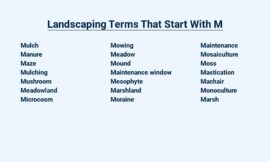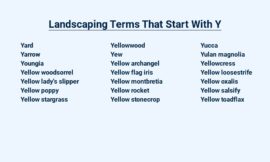Get ready to embark on a journey into the world of landscaping, where aesthetics meet functionality.
As we begin with terms starting with the letter “A,” we’ll explore concepts like acidic soil, aeration, annual flowers, arbors, and architectural plants.
We’ll delve into the beauty of autumn colors and discover the benefits of artificial lawns.
Join me to unravel the secrets of transforming your outdoor space into a vibrant and inviting oasis.
| A | |
| Accent Plant | Plant used to draw the eye or serve as a focal point in a landscape design. |
| Annual | Plant that completes its life cycle in one growing season. |
| Arbor | Covered walkway supported by columns or arches. |
| Artificial Grass | Synthetic material used to create the appearance of natural grass without the need for mowing, watering, or fertilizing. |
| Backfill | Material used to fill in a trench or hole after a project is complete. |
Annuals: Plants that complete their life cycle in one growing season, from seed to flower to seed again. Examples include petunias, marigolds, and zinnias.
Asparagus dagger: A type of evergreen fern with long, narrow leaves that resemble asparagus fronds. It is often used as groundcover or in containers.
Autumn colors: The vibrant hues that leaves take on in the fall as chlorophyll production decreases. Common autumn colors include red, orange, yellow, and purple.
Azalea: A type of flowering shrub with colorful blooms in spring. Azaleas are often used in foundation plantings, borders, and containers.
Arbor: A garden structure consisting of a framework of beams and pillars that supports climbing plants. Arbors can be used to create a shady spot in the garden, to define a pathway, or to simply add a decorative element.
Aster: A type of flowering plant with daisy-like blooms in a variety of colors. Asters are often used in borders, meadows, and cut flower gardens.
Awning: A structure that is attached to the exterior of a building and projects outward to provide shade or shelter from the sun or rain. Awnings can be made of a variety of materials, including canvas, metal, or wood.
Alfalfa: A perennial leguminous plant grown as a forage crop for livestock. Alfalfa is also sometimes used as a cover crop or green manure.
Alligator juniper: A type of evergreen coniferous tree with a distinctive pyramidal shape. Alligator junipers are often used in landscaping as specimen plants, in foundation plantings, or as hedges.
Allium: A genus of flowering plants that includes onions, garlic, and leeks. Alliums are often used in herb gardens and vegetable gardens, but some species are also grown as ornamental plants.
Artemisia: A genus of flowering plants that includes sagebrush and wormwood. Artemisias are often used in xeriscaping and other low-water landscapes.
Anemone: A genus of flowering plants that includes poppy anemones, windflowers, and pasque flowers. Anemones are often used in rock gardens, borders, and cut flower gardens.
Azalea: A genus of flowering shrubs that includes rhododendrons and mountain laurels. Azaleas are often used in foundation plantings, borders, and containers.
Ash: A genus of deciduous trees that includes white ash, green ash, and black ash. Ash trees are often used as shade trees or in windbreaks.
Aspen: A genus of deciduous trees that includes quaking aspen and bigtooth aspen. Aspens are often used as shade trees or in windbreaks.
Aster: A genus of flowering plants that includes Michaelmas daisies and New England asters. Asters are often used in borders, meadows, and cut flower gardens.
Athyrium: A genus of ferns that includes lady ferns and maidenhair ferns. Athyriums are often used in shade gardens and woodland gardens.
Aubrieta: A genus of flowering plants that includes rock cress and basket-of-gold. Aubrietas are often used in rock gardens, borders, and containers.
Ajuga: A genus of flowering plants that includes bugleweed and carpet bugleweed. Ajuga is often used as groundcover or in containers.
Alyssum: A genus of flowering plants that includes sweet alyssum and hoary alyssum. Alyssums are often used in rock gardens, borders, and containers.
Landscaping Terms Starting with A
Acidic soil
Acidic soil, characterized by a pH below 7, can be challenging for plant growth.
Acid-loving plants thrive in these conditions, while others may struggle to absorb nutrients and may exhibit signs of stress or poor growth.
Soil pH can be adjusted with the addition of lime or other amendments to create a more favorable environment for a wider range of plants.
Aeration
Aeration involves perforating or loosening soil to improve air circulation, drainage, and root penetration.
It can be done manually with a garden fork or aerating tool, or mechanically with a core aerator or similar equipment.
Annual flower
Annual flowers are grown and complete their life cycle within a single growing season.
They bloom profusely and add vibrant colors to landscapes, gardens, and containers.
Popular annuals include marigolds, zinnias, petunias, impatiens, and sunflowers.
Arbor
Arbor, a garden structure, typically consists of a framework of beams and pillars supporting a canopy of climbing plants. Often used as a shady retreat or decorative feature, it adds aesthetic appeal and natural beauty to any landscape.
Architectural plants
Architectural plants are landscaping elements valued for their structural form, shape, and overall design impact, rather than primarily for their flowers or foliage. They add visual interest and create striking focal points in the landscape.
Examples include columnar trees, topiaries, and plants with striking leaf patterns.
Artificial lawn
Artificial lawn, also known as synthetic turf, is a surface made from artificial materials designed to resemble natural grass. It is commonly used in sports fields, playgrounds, and residential landscaping due to its low maintenance requirements and durability.
Autumn colors
Autumn colors are a captivating display of nature’s artistry.
As the days grow shorter and temperatures cool, leaves transform into a vibrant palette of reds, oranges, yellows, and golds.
This annual spectacle signals the transition from summer to winter and brings a sense of wonder to the landscape.
Final Verdict
The world of landscaping is filled with diverse terminology, and those beginning with the letter “A” hold significant importance.
From understanding the properties of acidic soil to implementing aeration techniques, the terms explored provide a glimpse into the intricate world of landscaping.
Embracing annual flowers, incorporating architectural plants, and installing artificial lawns adds vibrancy and functionality to outdoor spaces.
Moreover, appreciating autumn colors not only enhances aesthetic appeal but also signifies the cyclical nature of the seasons.
Whether you’re a seasoned landscaper or just starting your gardening journey, these “A” terms offer a foundation for creating and maintaining beautiful, thriving landscapes.




